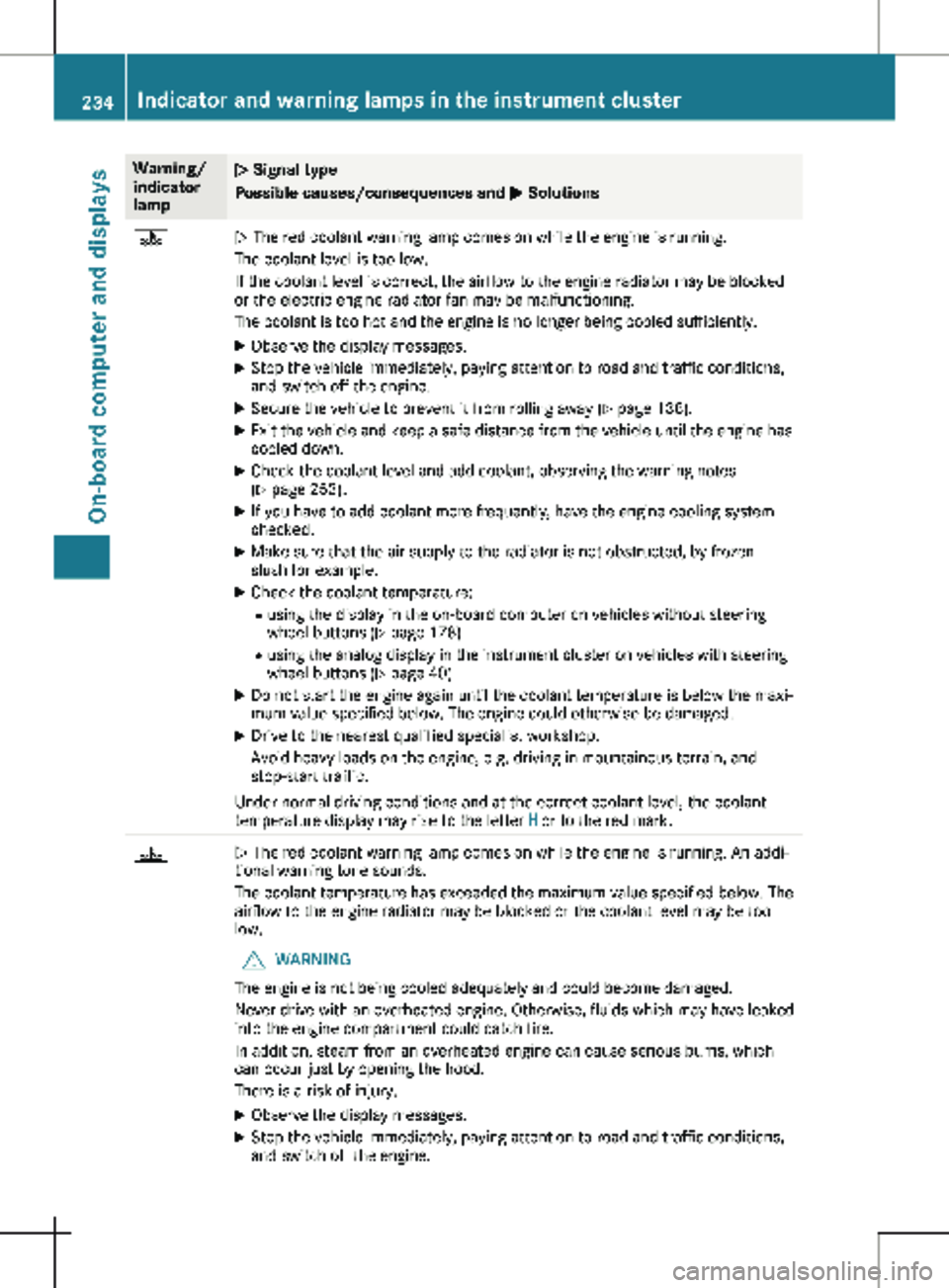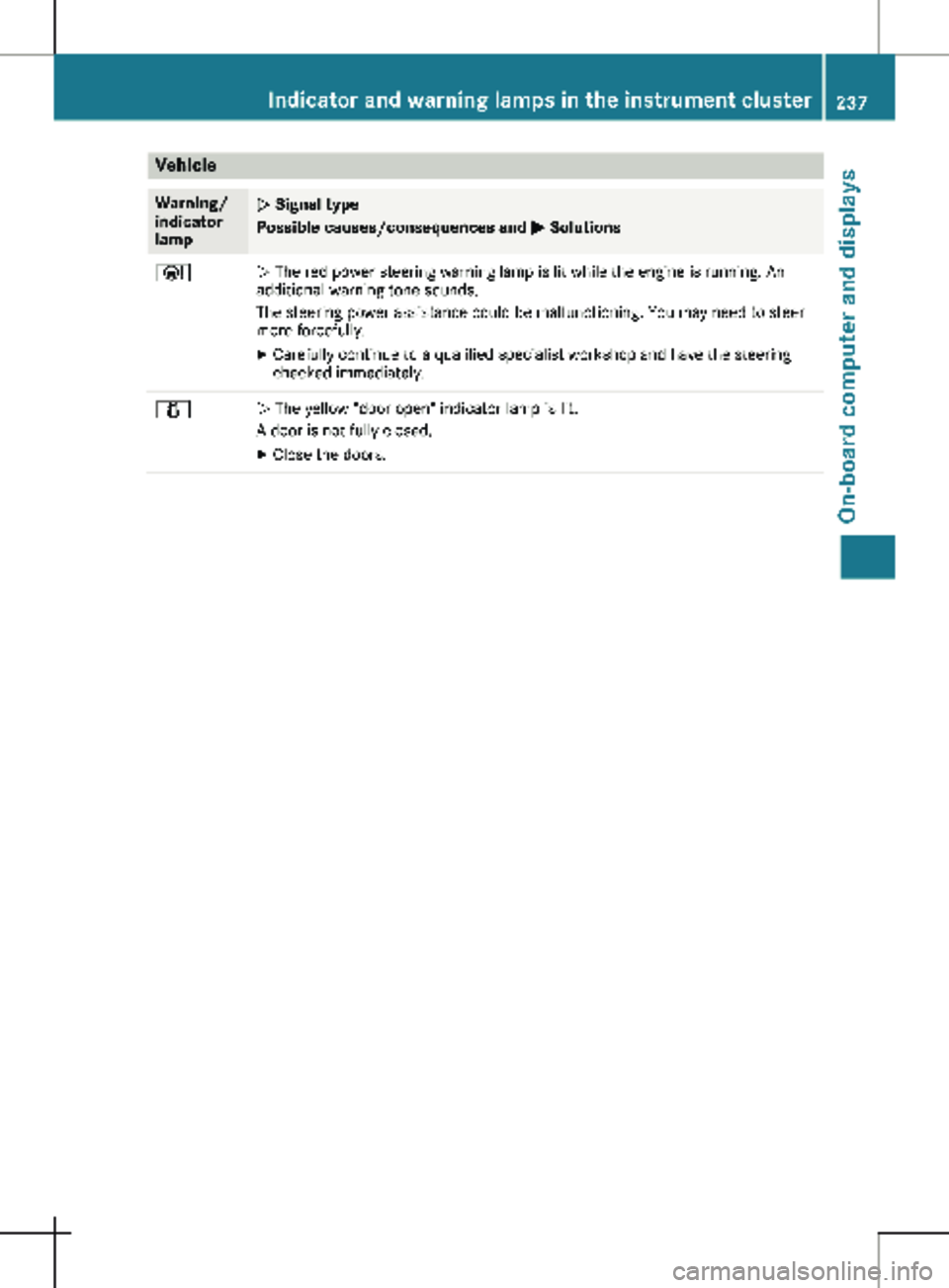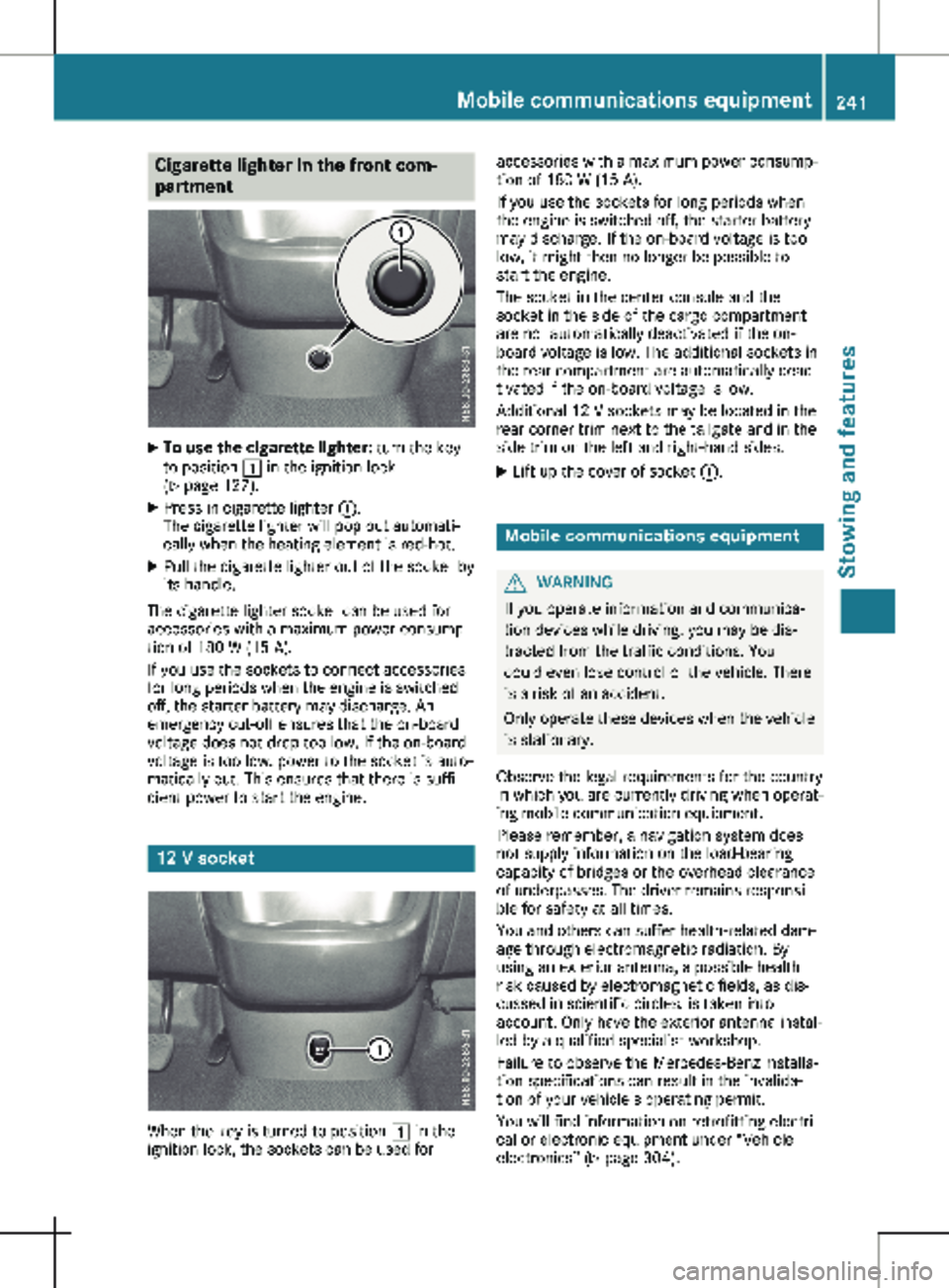engine MERCEDES-BENZ METRIS 2020 MY20 Operator’s Manual
[x] Cancel search | Manufacturer: MERCEDES-BENZ, Model Year: 2020, Model line: METRIS, Model: MERCEDES-BENZ METRIS 2020Pages: 320, PDF Size: 26.38 MB
Page 230 of 320

Seat belts
Warning/
indicator
lamp
N Signal type
Possible causes/consequences and
M Solutionsü
N After starting the engine, the red seat belt warning lamp lights up or flashes.
A warning tone may also sound.
Only for certain countries: the red seat belt warning lamp lights up for a maxi-
mum of 6 seconds after the ignition is switched on.
The seat belt warning lamp reminds the driver and front-passenger to fasten
their seat belts.
X Fasten seat belt ( Y page 50).ü
N The red seat belt warning lamp lights up after the engine starts, as soon as
the driver's or the front-passenger door is closed.
The driver or front-passenger has not fastened their seat belt.
X Fasten seat belt (Y page
50).
The warning lamp goes out.
On vehicles with the Occupant Classification System (OCS), there are objects
on the front-passenger seat.
X Remove the objects from the front-passenger seat and store them in a safe
place.
The warning lamp goes out. ü
N The red seat belt warning lamp flashes and an intermittent audible warning
sounds.
The driver or front passenger has not fastened their seat belt. At the same time,
you are driving faster than
15 mph (25 km/h) or have briefly driven faster than
15 mph (25 km/h).
X Fasten seat belt (Y page
50).
The warning lamp goes out and the intermittent audible warning ceases.
On vehicles with the Occupant Classification System (OCS), there are objects
on the front-passenger seat. At the same time, you are driving faster than
15 mph (25 km/h
) or have briefly driven faster than 15 mph (25 km/h).
X Remove the objects from the front-passenger seat and store them in a safe
place.
The warning lamp goes out and the intermittent warning tone ceases.228
Indicator and warning lamps in the instrument cluster
On-board computer and displays
Page 231 of 320

Safety systems
Warning/
indicator
lamp
N Signal type
Possible causes/consequences and
M Solutions$J
ò
N $ (USA only) or J (Canada only): the ABS and brake warning lamps
are lit while the engine is running.
EBD is unavailable due to a malfunction. ABS, BAS, hill start assist and ESP
®
as
well as its driving safety systems, for example, are therefore also unavailable.
ATTENTION ASSIST is deactivated and other driving systems could be automati-
cally deactivated.
G WARNING
The brake system continues to function normally, but without the functions lis-
ted above. The wheels could therefore lock prematurely if you brake hard, for
example.
This causes steerability and braking to be greatly impaired. The braking distance
may increase in emergency braking situations.
If ESP ®
is not operational, ESP ®
will not stabilize the vehicle.
There is an increased risk of skidding and accidents.
X Switch the engine off, wait briefly and start the engine again.
X Check if the display message has disappeared and ESP ®
is operational.
X If the display message continues to be displayed:
R Drive on with care.
R Visit a qualified specialist workshop immediately. $J
N The red
$ (USA only) or J (Canada only) brake system warning lamp is
lit while the engine is running. An additional warning tone sounds.
There is insufficient brake fluid in the brake fluid reservoir.
G WARNING
Braking performance can be impaired.
There is a risk of an accident.
X Stop the vehicle immediately, paying attention to road and traffic conditions.
Do not continue driving under any circumstances.
X Secure the vehicle to prevent it from rolling away ( Y page 138).
X Do not add brake fluid. Adding more will not remedy the malfunction.
X Consult a qualified specialist workshop.
X Observe the display messages. Indicator and warning lamps in the instrument cluster
229
On-board computer and displays Z
Page 232 of 320

Warning/
indicator
lamp
N Signal type
Possible causes/consequences and
M Solutionsò!
N The yellow ABS warning lamp is lit while the engine is running.
ABS has been deactivated due to a malfunction. BAS, hill start assist and ESP
®
as well as its driving safety systems, for example, are therefore also deactiva-
ted.
ATTENTION ASSIST is deactivated and other driving systems could be automati-
cally deactivated.
G WARNING
The brake system continues to function normally, but without the functions lis-
ted above. The wheels could therefore lock prematurely if you brake hard, for
example.
This causes steerability and braking to be greatly impaired. The braking distance
may increase in emergency braking situations.
If ESP ®
is not operational, ESP ®
will not stabilize the vehicle.
There is an increased risk of skidding and accidents.
X Switch the engine off, wait briefly and start the engine again.
X Check if the display message has disappeared and ESP ®
is operational.
X If the display message continues to be displayed:
R Drive on with care.
R Visit a qualified specialist workshop immediately.
If the ABS control unit is faulty, there is also a possibility that other systems will
be restricted or unavailable. ÷
N The yellow ESP
®
warning lamp flashes while the vehicle is in motion.
ESP ®
or traction control is intervening because there is a risk of skidding or at
least one wheel has started to spin.
Cruise control is automatically deactivated.
X When starting off, do not depress the accelerator pedal more than is neces-
sary.
X Ease off the accelerator pedal while driving.
X Adapt your driving style to suit the weather and road conditions.
X Do not deactivate ESP ®
.
In rare cases , it may be best to deactivate ESP ®
(Y page
68).230
Indicator and warning lamps in the instrument cluster
On-board computer and displays
Page 233 of 320

Warning/
indicator
lamp
N Signal type
Possible causes/consequences and
M Solutions÷
N The yellow ESP
®
warning lamp is lit while the engine is running.
ESP ®
, BAS, hill start assist, ESP ®
trailer stabilization and Crosswind Assist are
unavailable due to a malfunction.
ATTENTION ASSIST is deactivated and other driving systems could be automati-
cally deactivated.
G WARNING
The brake system continues to function normally, but without the functions lis-
ted above.
The braking distance in an emergency braking situation can thus increase.
If ESP ®
is not operational, ESP ®
will not stabilize the vehicle.
There is an increased risk of skidding and accidents.
X Switch the engine off, wait briefly and start the engine again.
X Check if the display message has disappeared and ESP ®
is operational.
X If the display message continues to be displayed:
R Drive on with care.
R Visit a qualified specialist workshop immediately. Indicator and warning lamps in the instrument cluster
231On-board computer and displays Z
Page 234 of 320

Warning/
indicator
lamp
N Signal type
Possible causes/consequences and
M Solutionså
N The yellow ESP
®
OFF warning lamp is lit while the engine is running or the
ECO start/stop function is activated.
ESP ®
is deactivated. ESP ®
trailer stabilization and Crosswind Assist are deacti-
vated.
G WARNING
If ESP ®
is deactivated, vehicle stabilization assistance is significantly reduced.
There is an increased risk of skidding and accidents.
X Reactivate ESP ®
.
In rare cases , it may be best to deactivate ESP ®
(Y page
68).
X Adapt your driving style to suit the weather and road conditions.
If ESP ®
cannot be activated:
X Drive on with care.
X Have ESP ®
checked at a qualified specialist workshop. 6
N The red restraint system warning lamp is lit while the engine is running.
The restraint system is faulty.
G WARNING
The air bags or Emergency Tensioning Devices may either be triggered uninten-
tionally or, in the event of an accident, may not be triggered.
There is an increased risk of injury.
X Observe the display messages.
X Drive on with care.
X Have the restraint system and its components checked immediately at a
qualified specialist workshop.
Further information on the restraint system and its components can be found
under "Occupant safety"
(Y page 46).232
Indicator and warning lamps in the instrument cluster
On-board computer and displays
Page 235 of 320

Engine
Warning/
indicator
lamp
N Signal type
Possible causes/consequences and
M Solutions;
N The yellow Check Engine warning lamp lights up while the engine is running.
There may be a malfunction in the following vehicle systems:
R in the engine management
R in the transmission management
R in the fuel injection system
R in the exhaust system
R in the ignition system (for vehicles with a gasoline engine)
R in the fuel system
The emission limit values may be exceeded and the engine may be running in
emergency mode.
X Have the vehicle checked as soon as possible at a qualified specialist work-
shop. 6
N The yellow reserve fuel warning lamp is on while the engine is running.
The fuel level has dropped to the reserve range.
X Refuel at the nearest gas station. ?
N The red coolant warning lamp comes on while the engine is running.
On vehicles without steering wheel buttons, the coolant temperature gauge is at
the start of the bar display
(Y page 178).
On vehicles with steering wheel buttons, the coolant temperature gauge is at
the start of the scale in the instrument cluster ( Y page 40).
The temperature sensor for the coolant temperature gauge is faulty.
The coolant temperature is no longer being monitored. There is a risk of engine
damage if the coolant temperature is too high.
X Stop the vehicle immediately, paying attention to road and traffic conditions,
and switch off the engine. Do not continue driving under any circumstances.
X Secure the vehicle to prevent it from rolling away (Y page
138).
X Consult a qualified specialist workshop. Indicator and warning lamps in the instrument cluster
233
On-board computer and displays Z
Page 236 of 320

Warning/
indicator
lamp
N Signal type
Possible causes/consequences and
M Solutions?
N The red coolant warning lamp comes on while the engine is running.
The coolant level is too low.
If the coolant level is correct, the airflow to the engine radiator may be blocked
or the electric engine radiator fan may be malfunctioning.
The coolant is too hot and the engine is no longer being cooled sufficiently.
X Observe the display messages.
X Stop the vehicle immediately, paying attention to road and traffic conditions,
and switch off the engine.
X Secure the vehicle to prevent it from rolling away (Y page 138).
X Exit the vehicle and keep a safe distance from the vehicle until the engine has
cooled down.
X Check the coolant level and add coolant, observing the warning notes
(Y page
253).
X If you have to add coolant more frequently, have the engine cooling system
checked.
X Make sure that the air supply to the radiator is not obstructed, by frozen
slush for example.
X Check the coolant temperature:
R using the display in the on-board computer on vehicles without steering
wheel buttons ( Y page
178)
R using the analog display in the instrument cluster on vehicles with steering
wheel buttons ( Y page 40)
X Do not start the engine again until the coolant temperature is below the maxi-
mum value specified below. The engine could otherwise be damaged.
X Drive to the nearest qualified specialist workshop.
Avoid heavy loads on the engine, e.g. driving in mountainous terrain, and
stop-start traffic.
Under normal driving conditions and at the correct coolant level, the coolant
temperature display may rise to the letter H or to the red mark.?
N The red coolant warning lamp comes on while the engine is running. An addi-
tional warning tone sounds.
The coolant temperature has exceeded the maximum value specified below. The
airflow to the engine radiator may be blocked or the coolant level may be too
low.
G WARNING
The engine is not being cooled adequately and could become damaged.
Never drive with an overheated engine. Otherwise, fluids which may have leaked
into the engine compartment could catch fire.
In addition, steam from an overheated engine can cause serious burns, which
can occur just by opening the hood.
There is a risk of injury.
X Observe the display messages.
X Stop the vehicle immediately, paying attention to road and traffic conditions,
and switch off the engine. 234
Indicator and warning lamps in the instrument cluster
On-board computer and displays
Page 237 of 320

Warning/
indicator
lamp
N Signal type
Possible causes/consequences and
M SolutionsX
Secure the vehicle to prevent it from rolling away ( Y page 138).
X Exit the vehicle and keep a safe distance from the vehicle until the engine has
cooled down.
X Check the coolant level and add coolant, observing the warning notes
(Y page
253).
X If you have to add coolant more frequently, have the engine cooling system
checked.
X Make sure that the air supply to the radiator is not obstructed, by frozen
slush for example.
X Check the coolant temperature:
R using the display in the on-board computer on vehicles without steering
wheel buttons ( Y page
178)
R using the analog display in the instrument cluster on vehicles with steering
wheel buttons ( Y page 40)
X If the coolant temperature is below the maximum value specified below, you
can continue driving to the nearest qualified specialist workshop.
Avoid heavy loads on the engine, e.g. driving in mountainous terrain, and
stop-start traffic.
Under normal driving conditions and at the correct coolant level, the coolant
temperature display may rise to the letter H or to the red mark.Driving systems
Warning/
indicator
lamp
N Signal type
Possible causes/consequences and
M Solutions·
N The red distance warning lamp lights up while the vehicle is in motion.
The distance to the vehicle in front is too small for the speed selected.
X Increase the distance. ·
N The red distance warning lamp lights up while the vehicle is in motion. An
additional warning tone sounds.
You are approaching a vehicle or a stationary obstacle in your line of travel at
too high a speed.
X Be prepared to brake immediately.
X Pay particular attention to the traffic situation. You may have to brake or take
evasive action.
Further information about the distance warning function can be found under
"COLLISION PREVENTION ASSIST"
(Y page 149). Indicator and warning lamps in the instrument cluster
235
On-board computer and displays Z
Page 239 of 320

Vehicle
Warning/
indicator
lamp
N Signal type
Possible causes/consequences and
M SolutionsÐ
N The red power steering warning lamp is lit while the engine is running. An
additional warning tone sounds.
The steering power assistance could be malfunctioning. You may need to steer
more forcefully.
X Carefully continue to a qualified specialist workshop and have the steering
checked immediately. 1
N The yellow "door open" indicator lamp is lit.
A door is not fully closed.
X Close the doors. Indicator and warning lamps in the instrument cluster
237On-board computer and displays Z
Page 243 of 320

Cigarette lighter in the front com-
partment
X
To use the cigarette lighter: turn the key
to position 1 in the ignition lock
(Y page
127).
X Press in cigarette lighter :.
The cigarette lighter will pop out automati-
cally when the heating element is red-hot.
X Pull the cigarette lighter out of the socket by
its handle.
The cigarette lighter socket can be used for
accessories with a maximum power consump-
tion of 180 W
(15 A).
If you use the sockets to connect accessories
for long periods when the engine is switched
off, the starter battery may discharge. An
emergency cut-off ensures that the on-board
voltage does not drop too low. If the on-board
voltage is too low, power to the socket is auto-
matically cut. This ensures that there is suffi-
cient power to start the engine. 12 V socket
When the key is turned to position 1 in the
ignition lock, the sockets can be used for accessories with a maximum power consump-
tion of
180 W (15 A).
If you use the sockets for long periods when
the engine is switched off, the starter battery
may discharge. If the on-board voltage is too
low, it might then no longer be possible to
start the engine.
The socket in the center console and the
socket in the side of the cargo compartment
are not automatically deactivated if the on-
board voltage is low. The additional sockets in
the rear compartment are automatically deac-
tivated if the on-board voltage is low.
Additional 12 V sockets may be located in the
rear corner trim next to the tailgate and in the
side trim on the left and right-hand sides.
X Lift up the cover of socket :. Mobile communications equipment
G
WARNING
If you operate information and communica-
tion devices while driving, you may be dis-
tracted from the traffic conditions. You
could even lose control of the vehicle. There
is a risk of an accident.
Only operate these devices when the vehicle
is stationary.
Observe the legal requirements for the country
in which you are currently driving when operat-
ing mobile communication equipment.
Please remember, a navigation system does
not supply information on the load-bearing
capacity of bridges or the overhead clearance
of underpasses. The driver remains responsi-
ble for safety at all times.
You and others can suffer health-related dam-
age through electromagnetic radiation. By
using an exterior antenna, a possible health
risk caused by electromagnetic fields, as dis-
cussed in scientific circles, is taken into
account. Only have the exterior antenna instal-
led by a qualified specialist workshop.
Failure to observe the Mercedes-Benz installa-
tion specifications can result in the invalida-
tion of your vehicle's operating permit.
You will find information on retrofitting electri-
cal or electronic equipment under “Vehicle
electronics” (Y page
304). Mobile communications equipment
241
Stowing and features Z